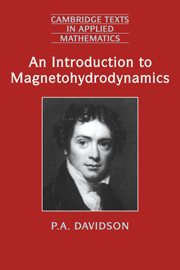Book contents
- Frontmatter
- Contents
- Preface
- Part A The Fundamentals of MHD
- Part B Applications in Engineering and Metallurgy
- Introduction: An Overview of Metallurgical Applications
- 8 Magnetic Stirring Using Rotating Fields
- 9 Magnetic Damping Using Static Fields
- 10 Axisymmetric Flows Driven by the Injection of Current
- 11 MHD Instabilities in Reduction Cells
- 12 High-Frequency Fields: Magnetic Levitation and Induction Heating
- Appendices
- Bibliography
- Subject Index
10 - Axisymmetric Flows Driven by the Injection of Current
Published online by Cambridge University Press: 26 February 2010
- Frontmatter
- Contents
- Preface
- Part A The Fundamentals of MHD
- Part B Applications in Engineering and Metallurgy
- Introduction: An Overview of Metallurgical Applications
- 8 Magnetic Stirring Using Rotating Fields
- 9 Magnetic Damping Using Static Fields
- 10 Axisymmetric Flows Driven by the Injection of Current
- 11 MHD Instabilities in Reduction Cells
- 12 High-Frequency Fields: Magnetic Levitation and Induction Heating
- Appendices
- Bibliography
- Subject Index
Summary
Matters of elegance should be left to the tailor and to the cobbler.
A. Einstein 1916When an electric current is made to pass through a liquid-metal pool it causes the metal to pinch in on itself. That is to say, like-signed currents attract one another, and so each part of the pool is attracted to every other part. When the current is perfectly uniform, the only effect is to pressurise the liquid. However, often the current is non-uniform; for example, it may spread radially outwards from a small electrode placed at the surface of the pool. In such cases the radial pinch force will also be non-uniform, being largest at places where the current density is highest (near the electrode). The (irrotational) pressure force, – ∇p, is then unable to balance the (rotational) Lorentz force. Motion results, with the fluid flowing inward in regions of high current density and returning through regions of small current.
Perhaps the first systematic experimental investigation of the ‘pinch effect’ in current-carrying melts was that of E F Northrup who, in 1907, injected current into pools of mercury held in a variety of different configurations. It should be noted, however, that industrial metallurgists have been routinely passing large currents through liquid metals since 1886, when Hall and Hèroult first developed the aluminium reduction cell and von Siemens designed the first electric-arc furnace. One of the many descendants of the electric-arc furnace is vacuum-arc remelting (VAR).
- Type
- Chapter
- Information
- An Introduction to Magnetohydrodynamics , pp. 332 - 362Publisher: Cambridge University PressPrint publication year: 2001

